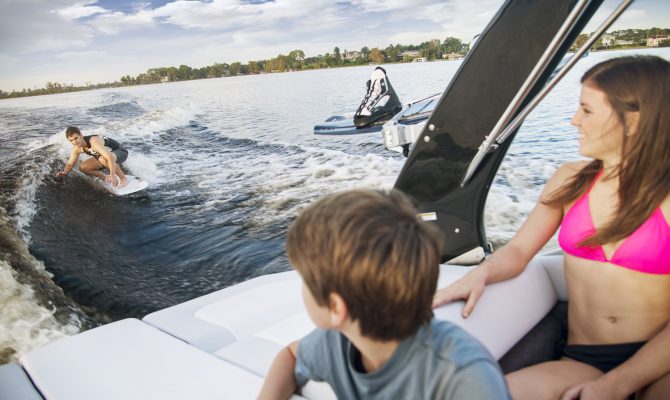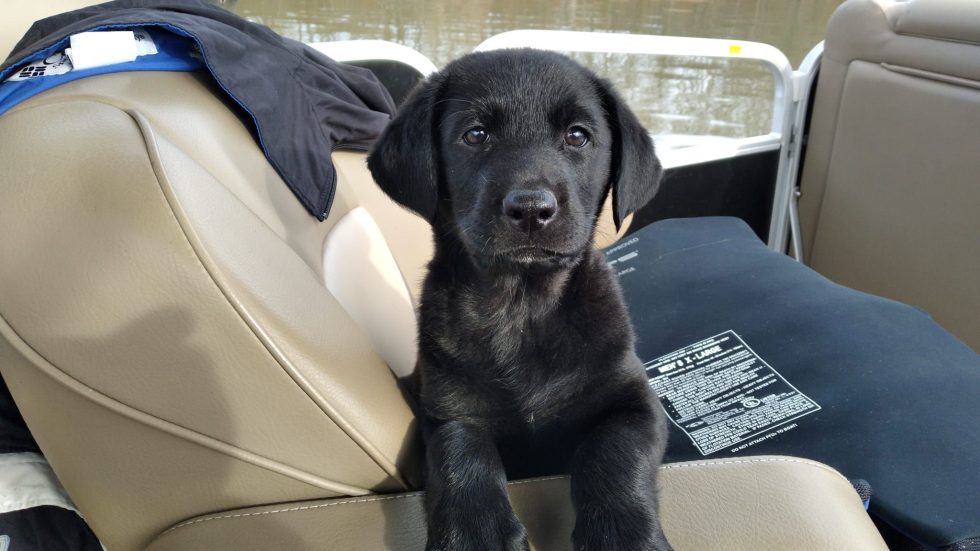One of the newest and fastest growing sports is wakesurfing, in which the rider trails behind a boat and surfs its wake without being directly pulled by a tow line. The wake from the vessel mimics the look and feel of an actual ocean wave.
It’s a wet and wild pursuit that some say is easier to master and enjoy than either waterskiing or wakeboarding, which is welcoming a broader age group to join in on the fun. And, because the surfing takes place at speeds of only 10 miles per hour or so, wipeouts are easier on the body.
The Wall Street Journal recently touched on the business-end of the wakesurfing buzz, noting the growth of the sport and the advances in boats that have made it possible for inland boaters. “It’s really opened up a huge market that wasn’t there before,” the paper quoted Justin Harrison of Idaho Watersports as saying.
Design and Conquer
Wakesurfing evolved as wakeboarders started messing about with the dimensions of their boards and the size of their boat wakes — and then, literally, cut the cord that connected them to the vessel. They started adapting their boards to the activity and fine-tuning their wakes to create the perfect wave for surfing.
As with other wake sports, both prop- and jet-driven boats designed to produce a large wave when ballasted and/or weighted are suitable platforms; wakesurfing-specific boats from popular boat manufacturers including Malibu and Chaparral are now available.
“Chaparral recognized the growing popularity of the sport and combined our exclusive Aerial Surf Platform package to coincide with the introduction of our new Vortex Jet Boats, capitalizing on the safety of a jet platform,” said company spokesperson Mike Munsch.
No matter what boat is being used to create the wake, the prime “surf” is usually found only about 10 feet behind the transom of a craft proceeding at between 8 and 12 miles per hour. The best wakesurfing boats create the largest wave possible at those slow speeds with a combination of ballast and adjustable grates or tabs to direct the flow of water passing under the transom.
Once a boat is tuned to offer a proper wake, all you need to surf it is a board designed for the purpose and a tow rope (in order to first get up).
Wakesurfing 411
Boards come in two styles: surf and skim. More traditional rides are offered by surf-style boards that feature multiple fins or “skegs” (usually in a set of three) to allow classic carving moves across the face of the wave. Skim-style boards have single, smaller skegs for a “looser” ride and more opportunity for spins and other tricks. As with ocean surfing, most beginners find that longer, wider surf-style boards are easier to start with when learning.
The ropes used for wakesurfing are shorter and thicker than those used in other tow-sports. The increased thickness of the line allows the rider grip anywhere along its length, and the smaller handle makes it easier to toss back into the boat once the surfer is up and using the energy of the wave to proceed. The length of the rope is determined by towing it in the wake and adjusting the amount of line until the handle reaches the curl of the surfable wave — normally no more than a dozen feet off the stern.
That combination of slow speed and short distance from the towboat makes wakesurfing appealing to enthusiasts outside of the normal 16- to 30-year-old age group that is targeted by promoters of more active, more strenuous tow-sports, according to Munsch.
“Wakesurfing can be enjoyed by practically anyone with good swimming and balance skills, and access to a boat built to offer the right wake,” he said, adding that there are lots of suitable boat designs out there now — and more to come.
“Interest and innovation in the sport has been growing steadily for about the past five years,” Munsch added. “And its evolution is still in its infancy. It’s going to be really fun to watch where this sport goes in the future.”
Author: Dan Armitage is a regular contributor to HeartLand Boating
Wakesurfing Pushback
Some say the specialized boats that create wakes for surfing should be outlawed. Lakeshore homeowners and conservationists worry that the boats could erode shorelines or disturb wildlife. Bans on wake-enhancing devices have been established at lakes in Oregon and Iowa, and word has it that Pennsylvania officials have fielded complaints about disturbance and damage allegedly caused by these boats.
Meanwhile, the wakesurfing boat lobby is active. The Water Sports Industry Association (WSIA) has hired Clifford Goudey, a former Coast Guard officer and Massachusetts Institute of Technology-educated consultant, to study the effects of wakesurfing. Goudey spent a week earlier this year measuring the wakes of wakesurfing craft as they passed electronic sensors on several lakes in central Florida. He will present his findings on how wake-enhancing boats affect shorelines, as compared to the effects of wakes from other types of watercraft, to the WSIA in the coming months.




